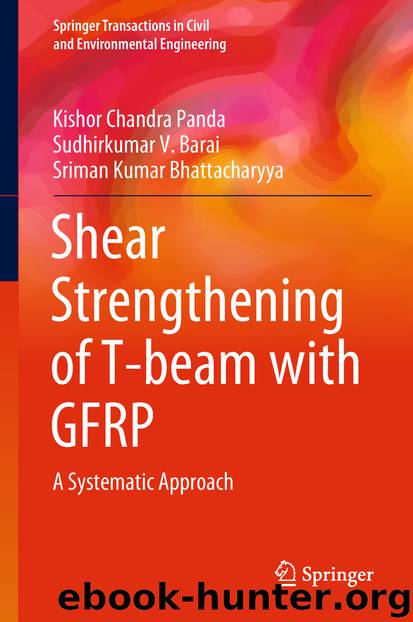Shear Strengthening of T-beam with GFRP by Kishor Chandra Panda Sudhirkumar V. Barai & Sriman Kumar Bhattacharyya

Author:Kishor Chandra Panda, Sudhirkumar V. Barai & Sriman Kumar Bhattacharyya
Language: eng
Format: epub
Publisher: Springer Singapore, Singapore
The debonding of GFRP layer from the concrete surface is observed in the specimens S200-1L-CT-U-90, S200-2L-CT-U-90 and S200-3L-CT-U-90 as shown in Fig. 4.14c. It is observed during experimentation that at an ultimate load of 182 kN, the GFRP layer gets debonded in the specimen S200-1L-CT-U-90. The debonding gets initiated from the top surface of the web of the T-beams. The rupture failure of GFRP layer is also observed along the diagonal shear failure line. Whereas in specimens S200-2L-CT-U-90 and S200-3L-CT-U-90, the GFRP layer gets debonded from the concrete surface at 208 and 192 kN, respectively (Panda et al. 2012). These two specimens the debonding gets initiated from the top surface of the web only, no rupture failure is observed. An inclined crack is also appeared at the side of the flange of the T-beams from loading points, and it propagates a distance of about 185, 200 and 380 mm in S200-1L-CT-U-90, S200-2L-CT-U-90 and S200-3L-CT-U-90 specimens, respectively.
The failure modes of RC T-beams strengthened in shear with U-jacketed GFRP wrap clearly indicates that in single layer wrapping most of the failure is due to GFRP sheet rupture, whereas for two and three layers the failure is due to GFRP debonding.
Download
This site does not store any files on its server. We only index and link to content provided by other sites. Please contact the content providers to delete copyright contents if any and email us, we'll remove relevant links or contents immediately.
The Body: A Guide for Occupants by Bill Bryson(4974)
Audition by Ryu Murakami(4850)
Adulting by Kelly Williams Brown(4487)
Housekeeping by Marilynne Robinson(4347)
Be in a Treehouse by Pete Nelson(3947)
Zero Waste Home by Bea Johnson(3777)
Seriously... I'm Kidding by Ellen DeGeneres(3577)
Better Homes and Gardens New Cookbook by Better Homes & Gardens(3525)
The Healing Self by Deepak Chopra(3474)
Barkskins by Annie Proulx(3313)
Hedgerow by John Wright(3275)
The Cellar by Natasha Preston(3261)
Spark Joy by Marie Kondo(3249)
The Genius of Japanese Carpentry by Azby Brown(3224)
The Life-Changing Magic Of Tidying Up- The Japanese Art Of Decluttering And Organizing (v5.0) by Marie Kondo(3211)
120 Days of Sodom by Marquis de Sade(3180)
Work Clean by Dan Charnas(3048)
The Book of Numbers by Peter Bentley(2912)
A Monk's Guide to a Clean House and Mind by Shoukei Matsumoto(2868)
